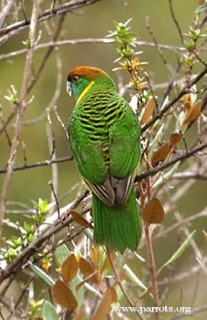Painted Tiger Parrot |
|
|
Also known as: Painted Ground Parrot, Timberline Parrot
Photos
View in GalleryDid You Know?
The species which make up this genus, or group, are among the least known of all parrots.Academic Research
Related publications: Psittacella pictaSpecies Profile
Genus: Psittacella | Species: picta
Size:
19cm (7.4 in)
Weight:
48-60g (1.7-2.1 oz)
Subspecies including nominate:
three: P.p. picta, P.p. excelsa, P.p. lorentzi
Colour Adult:
P.p. picta: Male-body mostly green; crown and surrounding area red/brown; sides of neck have thin yellow band; throat and upper breast washed with blue; mantle and back green barred with black; red rump and upper and undertail coverts; tail green. Bill blue/grey tipped with white. Eye orange. Female-as in male but yellow band on neck absent; cheeks and ear coverts green/blue; breast and sides of abdomen yellow striped with black.
P.p. excelsa: Male-as in picta, but crown bright olive/brown. Female-as in picta but head bright olive/brown; throat and cheeks strongly washed with blue.
P.p. lorentzi: Both adults as in picta but crown and surrounding area olive/brown; cheeks blue/green, with darker green on ear coverts; rump and upper tail coverts green/yellow striped with black.
Colour Juvenile:
As in adult female but head brown with green edges to feathers.
Call:
Are described as nasal and slightly musical. Eastern birds sound harsher in tone. Err-ee note from P.p. lorentzi.
More Information:
Content Sources:
CITES
BirdLife International
Cornell Lab of Ornithology/Birds of the World
Parrots: A Guide to Parrots of the World, Juniper and Parr, 1998
Parrots of the World, Forshaw, 2006. 2010 edition
Lexicon of Parrots, Thomas Arndt.
Photos
View in GalleryDid You Know?
The species which make up this genus, or group, are among the least known of all parrots.Academic Research
Related publications: Psittacella pictaSpecies Care
Captive Status:
Not found in aviculture.
Longevity:
Not recorded.
Housing:
Not recorded.
Diet:
Not recorded.
Enrichment:
Not recorded.
Nest Box Size:
Not recorded.
Clutch Size:
Not recorded.
Incubation Time:
Not recorded.
Fledging Age:
Not recorded.
Hatch Weight:
Not recorded.
Peak Weight:
Not recorded.
Weaning Weight:
Not recorded.
Photos
View in GalleryDid You Know?
The species which make up this genus, or group, are among the least known of all parrots.Academic Research
Related publications: Psittacella pictaSpecies Wild Status
World Population:
Unknown, stable.
IUCN Red List Status:
Least Concern
CITES Listing:
Appendix II
Threat Summary:
Not globally threatened. A BirdLife “restricted-range” species. Widespread but either generally scarce or locally common.
Range:
P.p. picta: Wharton and Owen Stanley Ranges, SE Papua New Guinea.
P.p. excelsa: Central Highlands, Papua New Guinea.
P.p. lorentzi: Snow Mountains, Irian Jaya.
Habitat:
Found in montane forest, glades and forest edge, stunted moss forest, secondary growth habitat, alpine and subalpine shrubs, between 2400-4000m (7872-13,120 ft).
Wild Diet:
Eats seeds, small hard berries, and the fruits of Dacrydium conifers.
Ecology and Behaviour:
Feeds in low bushes, flying up to higher trees when startled. Generally quiet; seen singly, in pairs, or in groups up to six. Mixes with Madarasz's Tiger Parrot.
Clutch and Egg Size:
Not recorded.
Breeding Season:
June-August, with juvenile seen in October.
Photos
View in GalleryDid You Know?
The species which make up this genus, or group, are among the least known of all parrots.Academic Research
Related publications: Psittacella pictaMembers Only Resources
Please log-in now to find more research, resources and tools.
Not a Member?
Find more great information:
Gain exclusive access to 600+ pages of additional research, seminars and podcasts, specialists to ask your toughest questions, and dozens of other fun resources - when you become a WPT member.
Join Today >>

































